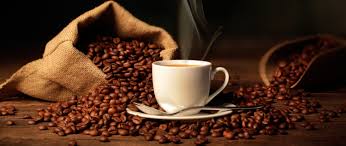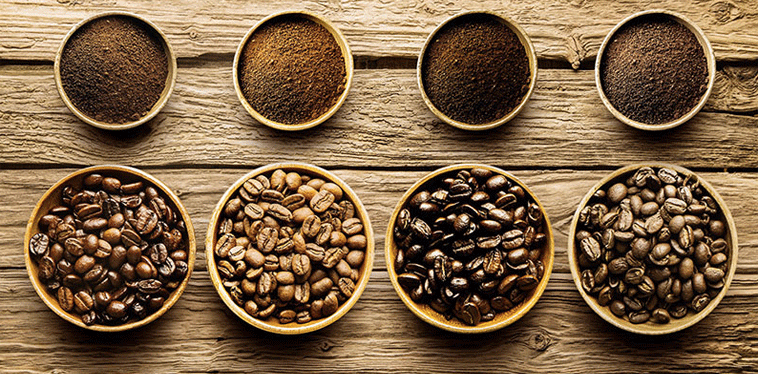Coffee
Definition of coffee
A beverage made by percolation, infusion, or decoction from the roasted and ground seeds of a coffee plant.
Because the beans are very shelf stable at this point, they are sold and shipped green.
Coffee Bean Varieties and Types
Coffee beans vary in their size, shape, color and flavor depending on the region and conditions in which they were grown. The range of unique flavors and aromas between regional varietals is as expansive as the variety of wine available from different vineyards. It is well worth experimenting with different varietals to discover a bean perfect for your palate.
Most regional varietals will fall into two main categories, Robusta or Arabica.
- Arabica: Arabica coffee is considered superior to Robusta because of its delicate flavor and low acidity. This variety is grown at higher altitudes and can be more difficult and costly to grow. These labor-intensive, low-yield plants produce a high-demand bean that sells for a higher price.
- Robusta: Robusta coffee tends to have a more acidic and harsh flavor than Arabica as well as higher levels of caffeine. Robusta can be grown at lower altitudes, in hotter climates, and with less moisture. Because Robusta has fewer growing restrictions and has a generally less desirable flavor, it is usually sold for a lower price than Arabica beans. Most mass-market commercial beans are of the Robusta variety.
Coffee Roasts
To prepare the green coffee bean for brewing, it must first be roasted. Coffee beans are roasted with dry heat and with constant agitation to ensure even heating. The range of roasts varies from light golden brown all the way to a dark, almost black appearance. Varying the roasting time has a significant effect on the flavor, aroma, and color of the brewed coffee.
Although there are several levels of roasting, they can be grouped into three main categories: light, medium, and dark.
- Light: Light roasts provide the lightest, most delicate flavors and can often be more acidic. Because there is less of a roasted flavor, the original flavor of the bean is allowed to shine through. High-quality beans or varietals with very distinct flavors are often roasted light to allow the original flavor to remain prominent. These beans will appear dry, as the bean has not been heated to the point where the oil is extracted. Light roasts include: Cinnamon, American, Half-City, and New England Roasts.
- Medium: Medium-roasted beans will have a chocolate brown color, dry surface, and a full flavor. These beans will have less acidity than light roasted beans and a slightly sweet, toasty flavor. Because of the balanced flavor and acidity, this is the most popular roast within the major commercial coffee market. Medium roasts are also known as Full City, Breakfast, or Regular Roast.
- Dark:Dark-roasted coffee is roasted until the sugars begin to caramelize and the oils begin to rise to the surface of the bean. Depending on the darkness of the roast, the bean may have a slight sheen or a very oily appearance. The flavor of dark-roasted beans is strong, smoky, and sometimes spicy. The original flavor of the bean is overpowered by the roasted flavor and therefore lower quality beans are often used for darker roasts. Although these roasts have a very low acidity, they are often described as bitter. Roasts that fall within the dark category include French, Viennese, Italian, and Espresso.
- Blends: To achieve unique flavor profiles, many roasters will create custom blends of beans with two or more roasting levels. This provides a depth of flavor and complexity that cannot be achieved with a single roast.
Caffeine and Decaffeination
Coffee is perhaps most prized for its caffeine content. The caffeine content in a cup of coffee varies widely depending on the type of bean used and the brewing method. While most of the caffeine is removed during the decaffeination process, trace amounts may still remain. The international standard for decaffeination requires that 97 percent of the caffeine be removed from decaffeinated coffee while the European Union’s standards require no less than 99.9 percent to be removed.
Most methods of decaffeination follow the same basic principle: the beans are soaked in water, which allows the caffeine (and other chemicals responsible for flavor) to leach out of the beans.
The extracted liquid is then either passed through a filter or mixed with a solvent to remove only the caffeine and leave the other beneficial compounds. The flavor-rich, caffeine deficient solution is then re-introduced to the beans to allow the flavor to be reabsorbed.
The Swiss Water Method has gained popularity in recent years because it uses only water to remove caffeine but the process is long and laborious. Other solvents used in the decaffeinating process include carbon dioxide, ethyl acetate, or triglycerides. Each method has its own advantages and disadvantages including cost, time, labor, and effect on the final flavor.
Research is being conducted to produce coffee plants that are deficient of the caffeine synthase gene and therefore do not produce caffeine. This would eliminate the need for the decaffeination process and would not only reduce costs but it would also keep the original flavor of the bean completely intact.
Storing Coffee
Proper storage of coffee has a great impact on the flavor of the brewed cup. Enemies to coffee’s flavor include heat, oxygen, light, and moisture. Most commercial coffee today is sold in vacuum-sealed bags with one-way valves to allow gasses to escape while keeping oxygen out. Once the seal on the bag is broken, extra care must be taken to keep the beans fresh.
At home, coffee beans should be stored in an airtight container in a cool, dark, and dry place. Although some people advocate keeping coffee beans in either the refrigerator or freezer, this can present issues with exposure to circulating air, excess humidity, and absorption of rogue flavors.
After roasting or once the seal is broken on a vacuum-sealed bag, it is best to use the beans within two weeks. For this reason, buy only the quantity of coffee that will be used within two weeks to maintain freshness and flavor.
Now that you’re an expert on coffee, how it is made, and how it should be stored, you’re ready to brew.
Espresso (Short Black)
The espresso (aka “short black”) is the foundation and the most important part to every espresso based drink. So much so that we’ve written a guide on how to make the perfect espresso shot. But for the purposes of this post an espresso consists of:
• 1 Shot of espresso in an espresso cup
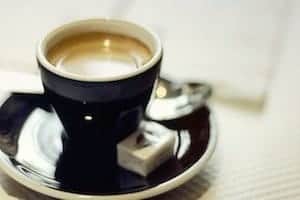 Double Espresso (Doppio)
Double Espresso (Doppio)
A double espresso (aka “Doppio”) is just that, two espresso shots in one cup. Therefore a double espresso consists of:
• 2 shots of espresso in an espresso cup
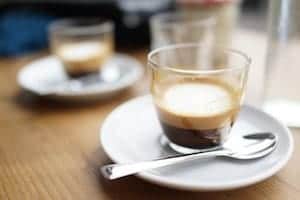 Short Macchiato
Short Macchiato
A short macchiato is similar to an espresso but with a dollop of steamed milk and foam to mellow the harsh taste of an espresso. You will find that baristas in different countries make short macchiatos differently. However the traditional way of making a short macchiato is as follows:
• 1 Shot of espresso in a short glass or espresso cup• A dollop of steamed milk and foam placed on top of the espresso
Barista tip: The key to the perfect short macchiato is the rule of thirds. That is you want three different colored layers in the macchiato. A bottom dark layer to represent the espresso, a middle layer that mixes the espresso and the milk, and a top layer of predominantly steamed milk. Refer to the picture above as an example.
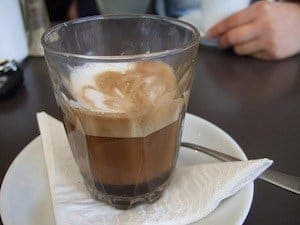 Long Macchiato
Long Macchiato
A long macchiato is the same as a short macchiato but with a double shot of espresso. The same rule of thirds applies in the traditionally made long macchiato:
• 2 shots of espresso in a tumbler glass or cup• A dollop of steamed milk and foam placed on top of the espresso
Barista tip: The key to making the perfect three layers is to place the dollop of steamed milk and foam on top of the espresso and then gently turning the cup clockwise a few times to mix the milk and espresso.
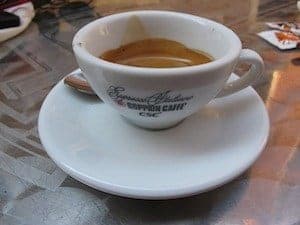 Ristretto
Ristretto
A ristretto is an espresso shot that is extracted with the same amount of coffee but half the amount of water. The end result is a more concentrated and darker espresso extraction. It is made as follows:
• Extract a standard espresso shot with half the amount of water.• Alternatively turn off a normal espresso extraction before the espresso starts to blonde.
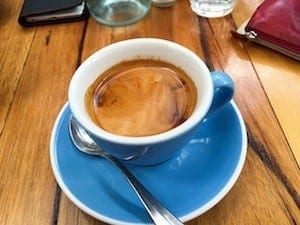 Long Black (Americano)
Long Black (Americano)
A long black (aka “americano”) is hot water with an espresso shot extracted on top of the hot water. It is made as follows:
• Fill a cup with 2/3rds full of hot water• Extract 1 shot of espresso over the hot water
Barista Tip: Make sure you back-wash your portafilter before making a long black, otherwise you might find grinds from your coffee grinder floating in your coffee.
 Café Latte
Café Latte
A café latte, or “latte” for short, is an espresso based drink with steamed milk and micro-foam added to the coffee. This coffee is much sweeter compared to an espresso due to the steamed milk. It is made as follows:
• Extract 1 shot of espresso into a tumbler glass• Add steamed milk• 1cm of micro-foam on top of the steamed milk
Barista tip: In the USA it is common to use a cup instead of a tumbler glass for a latte.
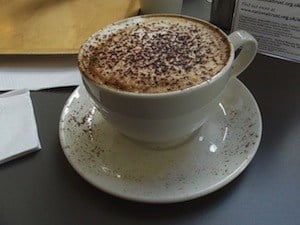 Cappuccino
Cappuccino
A cappuccino is similar to a latte. However the key difference between a latte and cappuccino is that a cappuccino has more foam and chocolate placed on top of the drink. Further a cappuccino is made in a cup rather than a tumbler glass. It is made as follows:
• Extract 1 shot of espresso into a cup • Add steamed milk• Add 2-3cm of micro-foam on top of the steamed milk• Sprinkle chocolate on top of the coffee.
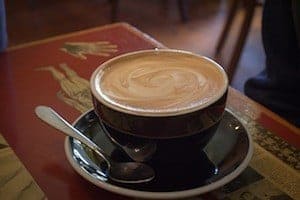 Flat White
Flat White
A flat white is a coffee you’ll primarily find in Australia and New Zealand. It is made the same as a cappuccino expect it does not have any foam or chocolate on top. It is made like this:
• 1 shot of espresso into a cup• Add steamed milk into the cup but no micro-foam
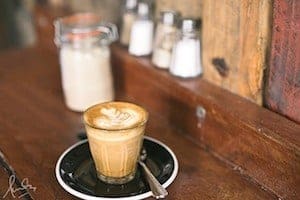 Piccolo Latte
Piccolo Latte
A piccolo latte is a café latte made in an espresso cup. This means it has a very strong but mellowed down espresso taste thanks to the steamed milk and micro foam within it. There are two ways of making a piccolo latte, with either 1 espresso shot or 1 ristretto shot:
• 1 shot of espresso or 1 ristretto shot of espresso in a espresso cup• Add steamed milk and small amount of micro-foam.
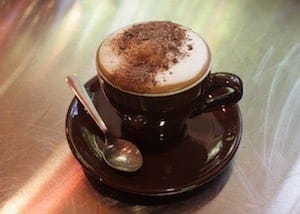 Mocha
Mocha
A mocha is a mix between a cappuccino and a hot chocolate. It is made by putting mixing chocolate powder with an espresso shot and then adding steamed milk and micro-foam into the beverage. The steps are as follows:
• Extract 1 shot of espresso into a cup• Add one spoon of chocolate powder into the espresso shot and mix• Add steamed milk• Add 2-3cm of micro-foam• Sprinkle chocolate powder on top.
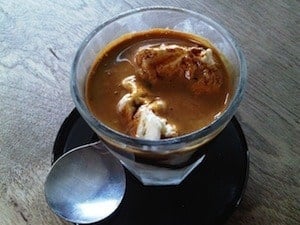 Affogato
Affogato
An affogato is a simple dessert coffee that is treat during summer and after dinner. It is made by placing one big scoope of vanilla ice cream within a single or double shot of espresso:
• Add one scoop of vanilla ice-cream into a tumbler glass milk• Pour a single or double shot of espresso over the vanilla ice-cream
Barista Tip: If you feel like an irish kick add a shot of Frangelico liqueur into the mix.










